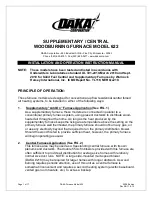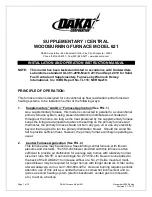
Specifications are subject to change without notice.
30
441 01 3400 02
VENTING NOTES FOR FIGURES 28 -- 40
1. For common vent, vent connector sizing and vent material: United States----use the NFGC.
2. Immediately increase to 5--inch (127 mm) or 6--inch (152 mm) vent connector outside furnace casing when 5--inch (127 mm) vent connector is required, refer to Note 1
above.
3. Side outlet vent for upflow and downflow installations must use Type B vent immediately after exiting the furnace, except when factory--authorized, Downflow Vent
Guard Kit, is used in the downflow position. See Specification Sheet for accessory listing.
4. Type--B vent where required, refer to Note 1 above.
5. Four--inch single--wall (26 ga. min.) vent must be used inside furnace casing and when the Downflow Vent Guard Kit is used external to the furnace. See Specification
Sheet for accessory listing.
6. Factory--authorized accessory Downflow Vent Guard Kit required in downflow installations with lower vent configuration. See Specification Sheet for accessory listing.
7. Chimney Adapter Kit may be required for exterior masonry chimney applications. Refer to Chimney Adapter Kit for sizing and complete application details. See
Specification Sheet for accessory listing.
8. Secure vent connector to furnace elbow with (2) corrosion--resistant sheet metal screws, spaced approximately 180
_
apart.
9. Secure all other single wall vent connector joints with (3) corrosion resistant screws spaced approximately 120
_
apart. Secure Type--B vent connectors per vent connector
manufacturer’s recommendations.
START--UP, ADJUSTMENT, AND SAFETY
CHECK
General
FIRE HAZARD
Failure to follow this warning could result in personal
injury, death and/or property damage.
This furnace is equipped with manual reset limit switches in
the gas control area. The switches open and shut off power
to the gas valve if a flame rollout or overheating condition
occurs in the gas control area. DO NOT bypass the
switches. Correct inadequate combustion air supply
problem before resetting the switches.
!
WARNING
CUT HAZARD
Failure to follow this caution may result in personal injury.
Sheet metal parts may have sharp edges or burrs. Use care
and wear appropriate protective clothing, safety glasses and
gloves when handling parts and servicing furnaces.
CAUTION
!
1. Maintain 115--v wiring and ground. Improper polarity will
result in flashing a status code 10 and no furnace opera-
tion.
2. Make thermostat wire connections at the 24--v terminal
block on the furnace control. Failure to make proper con-
nections will result in improper operation. (See Fig. 25.)
3. Gas supply pressure to the furnace must be greater than
4.5--In. W.C. (0.16 psig ) but not exceed 14--In. W.C. (0.5
psig).
4. Check all manual--reset switches for continuity.
5. Install blower compartment door. Door must be in place to
operate furnace.
6. Replace outer door.
Start--Up Procedures
FIRE AND EXPLOSION HAZARD
Failure to follow this warning could cause personal injury,
death and/or property damage.
Never test for gas leaks with an open flame. Use a
commercially available soap solution made specifically for
the detection of leaks to check all connections.
!
WARNING
1. Purge gas lines after all connections have been made.
2. Check gas lines for leaks.
3. To Begin Component Self--Test:
Remove blower access door. Disconnect the thermostat R
lead from the furnace control board. Manually close the
blower door switch closed. Short (jumper) the C terminal
on control to the TEST/TWIN 3/16--inch quick connect
terminal on control until LED goes out (approximately 2
sec). Gas valve and humidifier will not be turned on. (See
Fig. 24)
ELECTRICAL SHOCK HAZARD
Failure to follow this warning could result in personal
injury, or death.
Blower access door switch opens 115--v power to control.
No component operation can occur unless switch is closed.
Caution must be taken when manually closing this switch
for service purposes.
!
WARNING
NOTE
: The furnace control allows all components, except the
gas valve, to be run for short period of time. This feature helps
diagnose a system problem in case of a component failure.
Component test feature will not operate if any thermostat signal is
present at the control.
Component test sequence is as follows:
Refer to service label attached to furnace or see Fig. 44.
a. LED will display previous status code 4 times.
NOTE
: If no previous code is present, go directly to b.
b. Inducer motor starts and continues to run until Step f of
component test sequence.
c. Hot surface igniter is energized for 15 sec., then off.
d. Blower motor operates on HEAT speed for 10 sec.
e. Blower motor operates on COOL speed for 10 sec.
f. Inducer motor stops.














































